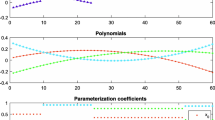Abstract
A basic and rather longstanding (e.g., [1]) question in the morphology community is the following: given a 1-D digital signal or a 2-D digital image, find another such signal or image that is both open and closed with respect to a given structural element and optimally “close” to the original signal or image. For binary 1-D signals, and a window of length M as structural element, this problem is a special instance of the following problem: given a finite-alphabet sequence of finite extent, \( y = \{ y(n)\}_{n = 0}^{N - 1} \), find a finite-alphabet sequence, \( \mathop X\limits^\wedge = \{ \mathop x\limits^\wedge (n)\}_{n = 0}^{N - 1} \), which minimizes \( d\left( {x,y} \right) = \sum\nolimits_{n = o}^{N - 1} {{d_n}(y(n),x(n))} \) subject to: X is piecewise constant of plateau run-length ≥ M. We show how a suitable reformulation of the problem naturally leads to a Viterbi-type solution. We call the resulting nonlinear I/O operator the Viterbi Optimal Runlength-Constrained Approximation (VORCA) filter. The VORCA is optimal, computationally efficient, and can be designed to be idempotent, and self-dual. The most intriguing observation is that the VORCA is not increasing, and, therefore, not a morphological filter.
N.D. Sidiropoulos can be reached (301) 405-6591, or via e-mail at nikos@Glue.umd.edu
Access this chapter
Tax calculation will be finalised at checkout
Purchases are for personal use only
Preview
Unable to display preview. Download preview PDF.
Similar content being viewed by others
References
F. Chen and P.A. Kelly, “Algorithms for generating and segmenting Morphologically smooth binary images”, in Proc. 26th Annual Conference on Information Sciences and Systems, Princeton University, Princeton, N.J., March 1992.
N.D. Sidiropoulos, “The Viterbi Optimal Runlength-Constrained Approximation Nonlinear Filter”, To appear: IEEE Trans. Signal Processing, March 1996 issue. Also available as Institute for Systems Research ISR TR 95–45; and University of Maryland at College Park, OTL Disclosure IS95–27.
A.J. Viterbi, “Error bounds for convolutional codes and an asymptotically optimum decoding algorithm”, IEEE Trans. Information Theory, vol. IT-13, pp. 260–269, Apr. 1967.
J.K. Omura, “On the Viterbi decoding algorithm”, IEEE Trans. Information Theory, vol. IT-15, pp. 177–179, Jan. 1969.
B. Sklar, Digital Communications, Prentice Hall, Englewood Cliffs, NJ, 1988.
N.D. Sidiropoulos, J.S. Baras, and C.A. Berenstein, “Optimal Filtering of Digital Binary Images Corrupted by Union/Intersection Noise”, IEEE Trans. Image Processing, vol. 3, no. 4, pp. 382–403, 1994.
N.D. Sidiropoulos, J.S. Baras, and C.A. Berenstein, “Further results on MAP Optimality and Strong Consistency of certain classes of Morphological Filters”, To appear: IEEE Trans. Image Processing. Also available as Institute for Systems Research ISR TR 94–84.
D. Schonfeld and J. Goutsias, “Optimal morphological pattern restoration from noisy binary images”, IEEE Transactions on Pattern Analysis and Machine Intelligence, vol. 13, pp. 14–29, 1991.
H.J.A.M. Heijmans, Morphological Image Operators, Academic Press, Boston, 1994.
J. Serra, Image Analysis and Mathematical Morphology, Academic Press, London, 1982.
J. Serra, Ed., Image Analysis and Mathematical Morphology. II: Theoretical Advances, Academic Press, London, 1988.
P. Maragos and R. W. Schafer, “Morphological filters — part I: Their set-theoretic analysis and relations to linear shift-invariant filters”, IEEE Trans, on Acoustics, Speech and Signal Proc., vol. ASSP-35, no. 8, pp. 1153–1169, Aug. 1987.
P. Maragos and R. W. Schafer, “Morphological filters — part II: Their relations to median, order-statistic, and stack filters”, IEEE Trans, on Acoustics, Speech and Signal Proc., vol. ASSP-35, no. 8, pp. 1170–1184, Aug. 1987.
Author information
Authors and Affiliations
Editor information
Editors and Affiliations
Rights and permissions
Copyright information
© 1996 Kluwer Academic Publishers
About this chapter
Cite this chapter
Sidiropoulos, N.D. (1996). The Viterbi Optimal Runlength-Constrained Approximation Nonlinear Filter. In: Maragos, P., Schafer, R.W., Butt, M.A. (eds) Mathematical Morphology and its Applications to Image and Signal Processing. Computational Imaging and Vision, vol 5. Springer, Boston, MA. https://doi.org/10.1007/978-1-4613-0469-2_23
Download citation
DOI: https://doi.org/10.1007/978-1-4613-0469-2_23
Publisher Name: Springer, Boston, MA
Print ISBN: 978-1-4613-8063-4
Online ISBN: 978-1-4613-0469-2
eBook Packages: Springer Book Archive




